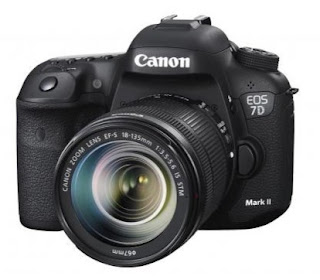2017 New Canon EOS 7D Mark II review
7D Mark II review - The EOS 7D Mark II sits at the highest point of Canon's scope of edited sensor SLRs. It's intended for experts, and especially the individuals who need rankling execution. A great many people why should arranging spend this much on a SLR would just consider a full-casing model, however there are circumstances where an edited sensor is more fitting.
The 1.6x product helps the central length of joined lenses, so as opposed to burning through £7,000 on Canon's 500mm telephoto lens, you could go for the 300mm lens at £1,100 and still accomplish a 480mm proportional central length. This telephoto augmentation comes to the detriment of wide-point ability, and the littler sensor will definitely push up commotion levels a bit. Nonetheless, games and natural life picture takers who tend to shoot far off subjects in daylight may well picked this over a full-casing SLR.
 |
| Canon EOS 7D Mark II review |
Remotely, it's fundamentally the same to the first EOS 7D, and much closer to the full-casing Canon EOS 5D Mark III. There are loads of top-level components, including a climate fixed magnesium combination body, CompactFlash and SDXC card openings, a liberal accumulation of attachments and heaps of catches and dials. There's a 1/8,000s most extreme screen speed, and to our ears the shade is calmer than on past EOS cameras. GPS is inherent for programmed geo-labeling of photographs. Interim shooting is incorporated surprisingly on a Canon SLR, catching shots at customary interims prepared to transform into a period slip video. One slight frustration is the 670-shot battery life – we'd expect closer 1,000 at this price.
Catches along the top plate allocate the summon dial and raise wheel to metering, drive and self-adjust modes, white equalization, ISO speed and streak remuneration. These are anything but difficult to work without removing the camera from your eye, with settings overlaid over the viewfinder picture. There's a scaled down joystick for moving the self-adjust point and a little lever encompassing it that pushes through the different extended self-adjust ranges, with a decision of one, five, nine, 15, 25 or every one of the 65 focuses. This is four a bigger number of focuses than on the 5D Mark III, and the most ever to effortlessness an EOS camera. These focuses are cross sort, which implies every one is really two sensors put at right plots for expanded affectability. The middle point is a double cross sort while utilizing lenses with f/2.8 or speedier openings, and is touchy down to EV - 3 for shooting in low light. There's no AF help light, however the camera didn't have numerous issues concentrating on ill defined subjects in melancholy conditions.
 |
| 2017 New Canon EOS 7D Mark II review |
Standard EOS 7D Mark II – self-adjust
Self-adjust execution is basic for games and natural life photography, and having 65 self-adjust focuses covering a particularly vast zone of the casing makes it simple to concentrate exactly on little subjects. It was to a great degree responsive when shooting with USM lenses, taking somewhere around 0.1 and 0.4 seconds from squeezing the screen catch to catching a shot. The AF-On catch means it's conceivable to allot self-adjust and screen discharge to partitioned catches, so you can picked when to refocus on subjects and when to shoot with no detectable slack by any stretch of the imagination. The speediest nonstop mode conveyed speeds somewhere around 9 and 10fps, with overhauled self-adjust for moving subjects scarcely making a scratch on execution. It kept this pace up inconclusively while shooting JPEGs to a quick SDHC card, and eased back to 1.9fps after 19 RAW casings.
 |
| 2017 New Canon EOS 7D Mark II review |
We weren't as inspired with the 7D Mark II's capacity to track moving subjects around the casing, however. It didn't appear to be as responsive or as dependable as Nikon's comparative 3D Tracking framework, and the different alternatives for modifying its following conduct motivated disarray more than certainty. As a matter of course it didn't give us a chance to characterize which self-adjust point the camera ought to take as its beginning stage, rather picking the closest subject or any recognized countenances. We in the long run found the alternative to characterize the beginning stage physically in the menu.
The 7D Mark II incorporates double pixel innovation for responsive live view self-adjust that we first found in the EOS 70D. It makes self-adjust in live view mode a suitable choice though it was miserably moderate on the first 7D. It's still much slower than when shooting with the viewfinder, however, taking between a half and one second to center and catch a shot. The screen was clear for a moment in the wake of shooting, and it could just gather a photograph like clockwork in live view mode. That may be helpful for large scale photography where utilizing the viewfinder isn't down to earth, yet it doesn't increase the value of the 7D Mark II. Truth be told, live view works better on the 70D, where the touchscreen makes it much snappier to move the self-adjust.
Comments
Post a Comment